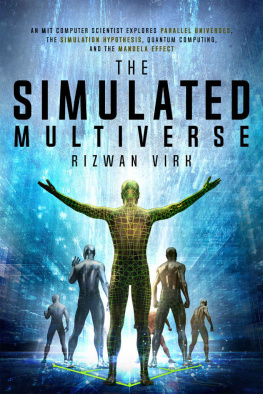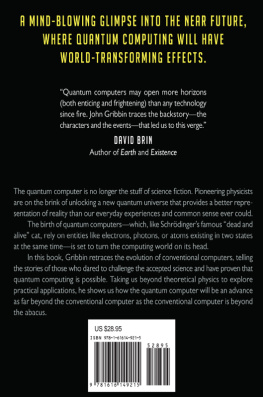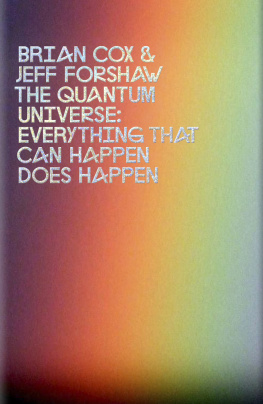Acknowledgments
I would like to thank all my teachers, particularly my family and friends.
My wife, Eve, and daughters, Emma and Zoe, exhibited great tolerance during the writing of this book. My parents, Robert and Susan Lloyd, were the books first readers and editors. My brothers Ben and Tom both contributed valuable questions, as did my nieces, nephews, cousins, uncles, aunts, and in-laws.
My friends at MIT and elsewhere gave many useful comments and criticisms, in particular Charlie Bennett, Paul Davies, and the members of the Moses seminar: Joel Moses, Bob Berwick, Robert Fano, Gadi Geiger, Jay Keyser, Tom Knight, Sanjoy Mitter, Arthur Steinberg, and Gerry Sussman. Terry Orlandos graduate reading group patiently read the manuscript and told me what they thought; I listened. JR Lucas, Janet Brown, and Aram Harrow helped me track down elusive typing monkeys. Murray Gell-Mann taught me quantum mechanics and complexity, and Doyne Farmer made me bicycle up and down high mountains while discussing the relation between the two topics. Shen Tsai helped me with Mencius.
All my colleagues in the field of quantum information and computation contributed greatly to this book via their own scientific work. Much of the research on which this book is based was funded by the Cambridge-MIT Initiative, the National Science Foundation, the Army Research Office, the Defense Advanced Research Projects Agency, the Advanced Research and Development Activity, the Naval Research Office, and the Air Force Office for Scientific Research.
Marty Asher at Knopf was a patient and sensitive editor. Any style in the prose is due to Sara Lippincott, who turned my jotting into writing. John Brockman forced me to write the book in the first place, and Katinka Matson held my hand while I did it.
Finally, Id like to thank those who are no longer here to be thanked, notably Heinz Pagels, Rolf Landauer, and Alexis Belash.
Personal Note: The Consolation of Information
My road to the concept of effective complexity has been a long and complex one. It began with my work with Heinz Pagels at Rockefeller, and it continued as my Ph.D. moved into view and I was offered a postdoctoral position with Rolf Landauer at IBM. Landauer was one of the founders of the field of physics of information. His motto, Information is physical, is an underlying principle of this book: all information that exists is registered by physical systems, and all physical systems register information.
I was somewhat surprised by the job offer. I had gone up to IBMs Watson Laboratories in Yorktown Heights that fall to deliver a talk on Maxwells demon. As part of my Ph.D. thesis (Black Holes, Demons, and the Loss of Coherence: How Complex Systems Get Information and What They Do with It), I had made a quantum-mechanical model of how one quantum system gets information about another and showed how such apparent violations of the second law of thermodynamics do not cause any actual violations. My talk had not gone too well. Landauer had been crusty. Charles Bennett had just published a definitive article on Maxwells demon that year, articulating far better than I had the trade-off between information and entropy. Perhaps worse, I inadvertently insulted Gregory Chaitin at lunch by making a joke about people who believe in the healing power of crystals, unaware that he kept a large crystal in his living room because it helped him concentrate.
Nevertheless, here was the impressive job offer, and I made preparations to go. Shortly after Landauers call, the head of my laboratory at Rockefeller walked into my office. Murray Gell-Mann wants to talk with you on the phone immediately, he declared. By now I was wary of professors walking into my office and making pronouncements. Why on earth would Gell-Mann want to talk with me? I had never met him (the fistfight in the convent hadnt happened yet), and I had no idea why the worlds best-known physicist would be interested in any of the peculiar stuff I was doing.
I picked up the phone. Where is your application to Caltech? Gell-Mann demanded. He was working on problems of complexity and on foundations of quantum mechanics and was having a hard time finding a postdoctoral fellow to work with him on these subjects. Hed been searching for months for someone who had done a Ph.D. in these fields and had finally come across me. He would piece together a postdoctoral position for me, if I was willing to accept. I had gone from no job to two job offers in the course of a week. It was a tough decision to make. Because I had missed the usual Caltech hiring process, the salary that Gell-Mann could offer me for the first year was half of what IBM was offering. On the other hand, I was excited by the prospect of going to Caltech. In the end, I decided to go west. It was the summer of 1988. I packed my belongings into my ten-year-old Datsun and started driving.
My first stop was Santa Fe, New Mexico, where I attended the first Santa Fe Institute Summer School and met Gell-Mann in person for the first time. We drove up to Los Alamos together and spent the afternoon debating the concept of complexity. Gell-Mann is a striking sight, with curly white hair and an electric smile. He is a remarkable person with whom to have a conversation, for the simple reason that he has about ten times the normal expected knowledge on virtually any subject you care to mention. He does not hesitate to let you know if your own speculations on the subject are mistaken. At one point in our three-hour discussion I hazarded an opinion about an aspect of quantum mechanics with which I was not sufficiently familiar. No, said Gell-Mann, his voice getting louder. No! Putting his forehead down on the table where we were sitting, he began pounding the table with his fists. No! No! No! No!! No!!! Here, I thought, was someone I could work with.
After a month in Santa Fe, I drove up to the Aspen Center for Physics to visit Heinz, who had a house outside Aspen, where he and Elaine and their two small children were spending the summer. Our work on thermodynamic depth had inspired debate in the scientific community and attention from science journalists. On a series of hikes in the Elk Mountains, we discussed our next work. Or rather, we spent a small fraction of the time discussing our next work; most of the time Heinz regaled me with wild stories about things other than physics. Atop Castle Peak, he spread his arms to the mountains around and declaimed, I present to you all the wealth and all the beautiful women in the world.
Two days later, disaster struck. Heinz and I had decided to climb Pyramid Peak, a 14,000-foot pile of rotten rock in the West Maroon wilderness about ten miles from Aspen. The day was fine; we started early and, taking care to avoid falling rock, we were at the top by noon. On the way down, we had to make a brief traverse with a lot of exposure; if you fell, you fell a long way. We edged along a crack in the rock, Heinz in front. At the end of the crack, he hopped onto a saddle between two crags. Heinzs ankle had been weakened by polio when he was a child. When his foot hit the saddle, his ankle buckled. He fell and slid out of sight down an almost vertical gully.
I called. There was no response. Quickly, before I froze up, I jumped from the crack to the saddle. It was a small, slightly awkward hop. I called again and again to silence. The gully was too steep to descend on my own, and Heinz had had the rope in his backpack. I turned and ran down the trail to get help.
There is no happy ending. The sheriff took me to tell Elaine what had happened, while the mountain rescue crew went to look for Heinz in the hope that he might still be alive in a crevice. When they couldnt find him, they took me back up the mountain in a helicopter. We rose slowly up into the great bowl of Pyramid Peak, the central part of it a cliff of sheer and rotten rock rising half a mile to the summit. We found where Heinz had fallen. There was no crevice. He had fallen 100 feet, hit hard, and dieda quick, clean death. After impact, his body had tumbled 2,000 feet farther down the mountain, where we found him on a shelf of rock. Slowly, we sank down out of the bowl. Then I went to give Elaine the bad news.
Next page





